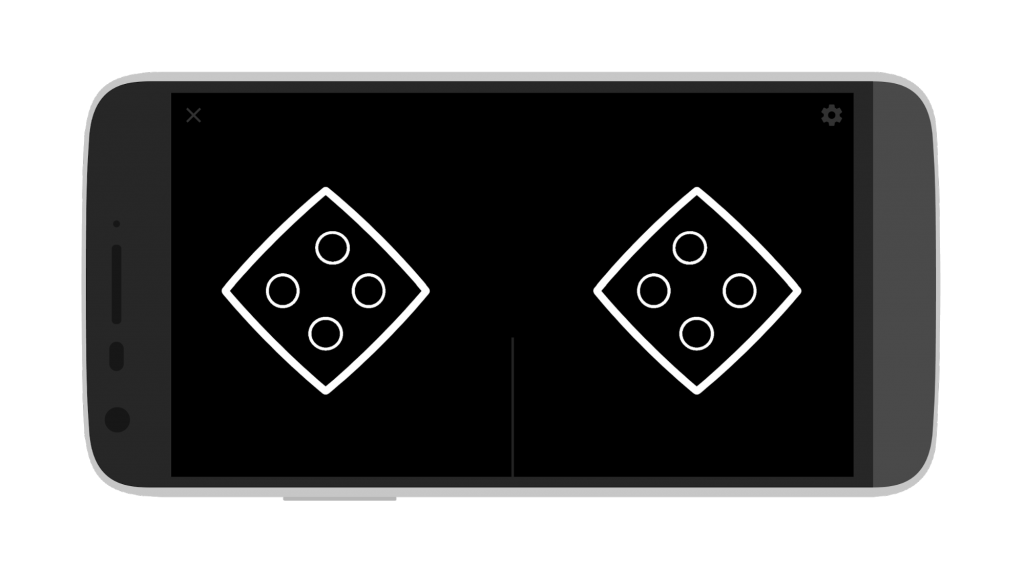What are EyeSkills building?
We are building tools to help people with amblyopia and strabismus (lazy eye) have a chance to learn more about their condition, their visual system, and even to open up some opportunities to overcome and even correct their condition.
Who and why are EyeSkills doing this?
My name is Ben Senior. I have a doctorate in Software Engineering, and have spent the last two decades inventing new tools and solutions in many and varied fields of interest. My family have a history of “lazy eye”, but only in an intermittent form. It was never something anybody really recognised or talked about. When my eldest son was around one year old, we noticed that he had a more severe form of lazy eye. At this point, some four years ago, I started on a journey which I expect will continue for many more years – into the neuroscience of vision, the processes behind medical praxis, and the difficulties of reaching the many millions of people who have no access to, nor can afford, any form of advice or basic help with this condition.
It is my personal goal for EyeSkills to leave a legacy – an open source framework which allows the community to focus its energies and efforts on a renewed exploration of what is possible when it comes to regenerating the full visual abilities of people with lazy eye.
The EyeSkills Philosophy
Our philosophy is to help you help yourself. This is not just an idle statement. Current medical intervention can remove the original problem which limited your sight, but you must then learn how to use both eyes again. We can try to provide your with carefully designed opportunities which will allow you to learn how to reuse both eyes, but that learning is your responsibility. As in any situation where you must learn and master a new skill, it requires time, patience, and above all, will-power.
Of course, you are probably asking yourself what the, seemingly impossible, recovery of binocular vision (the use of both eyes) has to do with learning! This is a perfectly valid question. You will need a great deal more skepticism, curiosity, and will to learn, if you are really going to unlock the visual abilities which are still there, waiting, in your mind. Lets go a little deeper.
The Lazy Eye is not the defect!
There are many initial situations which can trigger Lazy Eye – from being born premature and underweight, to having eyes of significantly different strength, cataracts, to alcohol poisoning or brain trauma. What *most* of them have in common, in most cases, is that the development of the visual system didn’t unfold in a normal way.
It seems that the building blocks of the visual system – the ability to coordinate input from both eyes, to judge depth from muscle tension in the eyes, to coordinate the movement of both eyes, and much more – are always there, ready and waiting in the brain. Because the final form of each human being is unpredictable, however – depending on the error-free processing of millions of genes, the wellbeing of the mother and child, pollution in the environment and many other factors – those building blocks must still be wired together after birth, to take into account the exact physical shape and mental abilities of the actual individual as they have actually been born and as they are growing.
The visual system is so important to our survival, such a central part of who we are, that it is linked to many different parts of our body and mind. It is intimately linked to our nervous system at all levels, detecting and compensating for body movement, connected to muscle and balance control to land a catch – or a strike – but also wired right into our consciousness, from being able to categorise different wavelengths of light entering our eyes as individual objects, to hearing and speech to share descriptions of what we see, or even reversing the flow to produce hallucinations and visions from thoughts and dreams.
This deep interconnectedness takes time to develop. It proceeds from the simplest stages – recognising the dark areas which are the parent’s eyes and mouth, to (in time) an aesthetic appreciation of the world around us. Some of the most pivotal moments relevant to Lazy Eye occur early in a baby’s development:The brain begins to recognise that each eye is looking at the same thing.
A baby becomes increasingly skilled at using both eyes together within its first year, and as it reaches out with its fingers and arms to touch the things it is looking at, it begins to learn that both eyes are looking at the same thing. It begins to understand that the larger and smaller a thing is, and the more or less both eyes are looking towards the center, the closer or further a way a thing is. It begins to connect a feeling of depth and distance, with what it is seeing and touching. In fact, the ability to judge and feel depth is somehow there, but it is now being activated and becoming finely tuned. This does raise the question, “why isn’t this system always activated, just waiting to be fine tuned?”.
One possible explanation is, that one of the things that can vary between children is whether or not both eyes are working correctly! Over course of the previous millions of years countless billions of animals will have been born with at least one malfunctioning eye – whether through disease, it having an incorrect shape, or being incorrectly connected to the rest of the brain. What would they see if the use of both eyes were hardwired? This is where we will understand that a Lazy Eye is both a curse and a blessing. It is a “blind” evolution which increases survivability, but which is not easily reversible, as the physical conditions which gave rise to it would not (in a natural world, without doctors or hospitals or science) normally be reversible!
Everything went according to plan!
As a baby develops normal sight, it begins to understand how to put the two slightly different images from each eye together to form what seems to be a single view of the world. This can be demonstrated by optical illusions like Magic Eye in which the brain can pick out a hidden image from what looks like nothing but a mass of noise, but only when using both eyes together.
If both eyes were always hardwired to be active, what would that mean for somebody born with quite different eye strengths (typically, one eye long sighted, and one eye short)? The light falling into each eye would be unfocused in two different ways, once reaching its focal point in front of the retina (the part of the eye containing the bit of your brain which turns light into electrical information), while the other eye would reach its focal point “behind” the retina. Simply put, the brain would be seeing two versions of the world so different that it couldn’t then bring them together.
With one eye long sighted, and one short sighted, each eye is also incorrectly focusing the world in opposite ways, it is also incredibly hard (if not impossible) to compensate for the issue by other means. For example, a short sighted perso might just squint to improve the focus of what they are seeing, but this would only make the long-sighted eye see even worse!
Another common cause of Strabismus (and Amblyopia – more on that later) are cataracts. Cataracts are a clouding of one of the eye’s lenses, causing the world to become increasingly blurred and greyed. Once again, the image received by the brain from each eye is totally different, so much so that it cannot bring the two images together.
In many cases, the problem is not even optical. For reasons unknown, the part of the brain responsible for bringing the two images together does not develop correctly, or at the right pace for the development of the animal. In this case, because the animal cannot coordinate both eye to look at the same thing at the same time, it also ends up with a confusing double-image of the world full of overlapping shifting shapes.
Seeing two different, overlapping views of the world, which prevents both eyes from moving in unison and tracking the same point, is not just confusing, and tiring, but dangerous. In the world we have evolved in, being able to see clearly, and judge distances accurately, has been key to our individual survival. Not seeing clearly, not being able to make judgments accurately and quickly, not being able to judge distances and speeds perfectly – means being killed or failing to make the kill (which often amounts to much the same thing in the long run).
This selective pressure means that, over millions of years, animals hardwired to always use both eyes have simply failed to pass on their genes, as they failed to survive long enough to have offspring. Through some mutation at some point in our lineage (when exactly remains an area of study) it became common for animals to delay connecting up both eyes until afer birth. Where the eyes could not form a common image, those animals could benefit from a new mutation which would switch the visual system to only using one eye, or only one eye at a time. The chances of surviving by seeing clearly with one eye are substantially higher than not seeing clearly with two eyes!
This compensating mechanism can even trigger in adulthood after an accident causing damage to the eye our brain!
The detection of when eyes are failing to see the same thing, seems to fall two a newly discovered group of specialised neural cells called conflict neurons. When these detect conflict, they trigger eye dominance cells to favour the input from one eye so strongly that input from the other eye simply “fades into the background”. This suppression is called “amblyopia”.
With one eye now, effectively, not reporting any signal back to the brain, the brain can no longer choose a target for that eye to point at . So what should the eye point at? The way an eyeball normally gets positioned is like a one-sided tug-of-war. It is constantly pulled to one side, up and diagonally (by one nerve bundle) whilst the fine-control is defined by exactly how much the opposite three muscles contract or relax (where each is controlled by its own individual nerve bundles). It is therefore hardly surprising that the eye will relax into an off center position as one-side wins the tug-of-war by default. This is called strabismus.
Unfortunately, there was no plan B
The lucky animal, born with a malfunctioning visual system, now has a fighting chance at survival! This is as good as it ever needed to get, except now, we humans are able to interfere in entirely new ways. We can wear glasses, have our eyes reshaped with laser beams, replace broken lenses inside the eye, lengthen or shorten eye muscles… and in doing so we can tackle many of the initial causes for strabismus and amblyopia. These interventions, however, do *not* fix either amblyopia nor strabismus. Why not?
In the case of amblyopia, the animal has learnt not to use one eye (or more than one eye at a time). In the case of strabismus, which generally follows amblyopia, it gets even worse. The amblyopia has led to each eye pointing in different directions, which means that – were both activated – we would be back at double-vision (as the eyes look in different directions) which would trigger conflict cells and cause one eye to be suppressed again! The brain has effectively maneuvered itself into a cul-de-sac it cannot get out of with external help!
We should also add that there is another side-effect to strabismus. It is conceivable that, in cases where one eye is permanently suppressed and positioned to one extreme position, the muscles controlling the eye may have atrophied. In this case they may be so weak that they are unable to either move the eye quickly, precisely, or even, at all.
Let’s rebuild those bridges
Let us imagine that we could reset the part of the brain which is causing one eye to be suppressed. This is the very first and most basic step towards being able to use both eyes at the same time. Unfortunately, it would only switch on a confusing double-vision if both eyes are looking in different directions. The visual system will, again, have no opportunity to learn how to use the two eyes together.
What needs to happen is something close to a recreation of the conditions during which the visual system was originally learning to use both eye. Where it failed to succeed due to physical problems with one or both eyes, it now has a chance if those physical problems have been removed or minimised. To relearn how to see, however, it now needs to overcome the obstacles which the brain has deliberately created to force monocular (one eyed) seeing.
The implication is that we must simultaneously break through suppression (so both eyes are sending a signal to the brain), whilst giving the brain a chance to learn both eyes together *despite* both eyes looking in different directions (so we need to remove the double-vision), whilst we also teach the visual system that it is capable of using both eyes together – pointed in the same direction (so we need to re-strengthen and nudge the brain into straightening the strabismic eye so it can maintain fusion).
If all this sounds like juggling five balls, blind-folded, with one hand tied behind your back, do not worry. We think, and our early testing is also suggesting, that it may not be as impossible as it sounds.
| What follows is a very brief introduction to the tools we are currently creating (in the second iteration of our prototype development) to help re-establish those broken connections. These scenes are designed for use by a professional, but they serve as a jumping off point for developing “take-home” versions. The most important thing to realise is that you have the power to build your own tools. Behind these scenes we are building an open-source framework which makes it simpler than ever to build such tools. If you are a researcher, amateur scientist, or want to explore your own visual problems more deeply – just get in touch or download the framework and get creative! |
Breaking Suppression
The hypothesis we follow, is that conflict neurons detect that both eyes are seeing the world too differently to cooperate, which then causes stimulation dominance cells to massively favour one eye (by releasing GABA inhibitors which block the end of the optical nerve of the other eye). We have seen some signs supporting this in our initial testing, as there seems to be two different ways to break through suppression.
Turn up the volume
A suppressed eye is not really completely switched off. Light entering the eye has been converted to an electrical signal which travels down the optical nerve towards the main brain, but is then prevented from travelling further by more than a trickle. It seems that specialised dominance neurons are responsible for inhibiting the signal from travelling further by releasing GABA inhibitors which attach to the end of the optical nerve. These can be almost instantaneously removed, as in the case of alternating strabismics which can switch the dominant eye at will and extremely quickly.
If you like, imagine that the signal from each eye is reaching the brain at different volumes. The signal from the dominant eye is strong and loud, whilst the signal from the suppressed eye is weak and quiet. Can we turn up the volume of the suppressed eye, whilst turning down the volume of the dominant eye, so that the brain receives two equal signals from two eyes, despite still trying to suppress one eye?
We created the Binocular Suppression calibration scene to do just this. Inside the VR headset the participant initially sees two grids – where each grid is seen only by one eye:
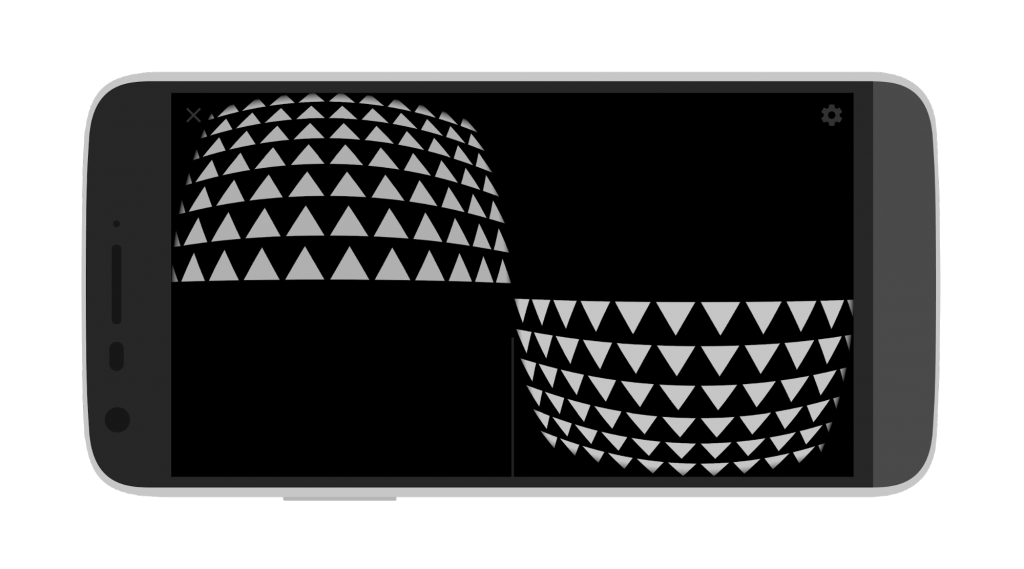
What we do not know is how they actually perceive these grids. If one eye is suppressed, one grid may simply be invisible, or only very dim. By simply raising or lowering their head, they can change the relative brightness (the ratio in brightness) between the two grids, and find a point at which both grids are perceived with an equal luminance:
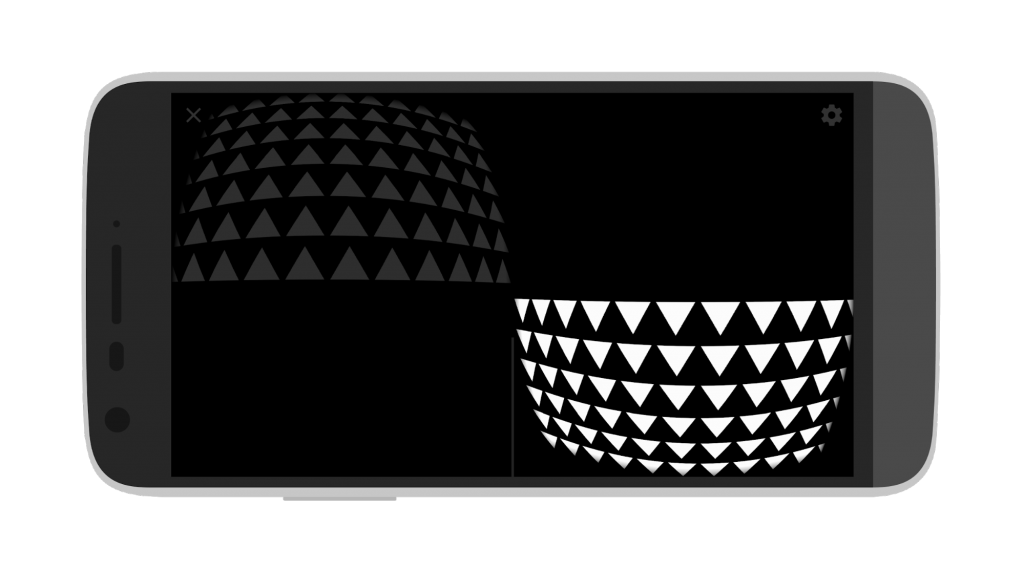
In this design the two grids are which are horizontally aligned and non-overlapping, and have the same absolute luminance. This has the benefit that the layout generally avoids stimulating conflict cells, as the most common forms of strabismus have either no, or very minor vertical eye misalignment. The two grids thus do not appear to be occupying the same perceived space as they are projected onto different non-overlapping parts of the retina despite any degree of horizontal eye misalignment.
This is relevant where suppression is *not* caused by conflict cells, however, we believe that the reverse is more common. The operator can thus shift the grids into conflict (vertically aligned) to see if this alters the luminance ratio needed to break suppression.
We chose triangles for these grids for two reasons. Firstly, they allow us to easily discuss which grid is being seen (pointing up/down) which also provides a visual cue for the direction in which to move the head to alter the luminance ratio. Perhaps more importantly, when in the conflicting position, it is never the case that they two can completely overlap one another.
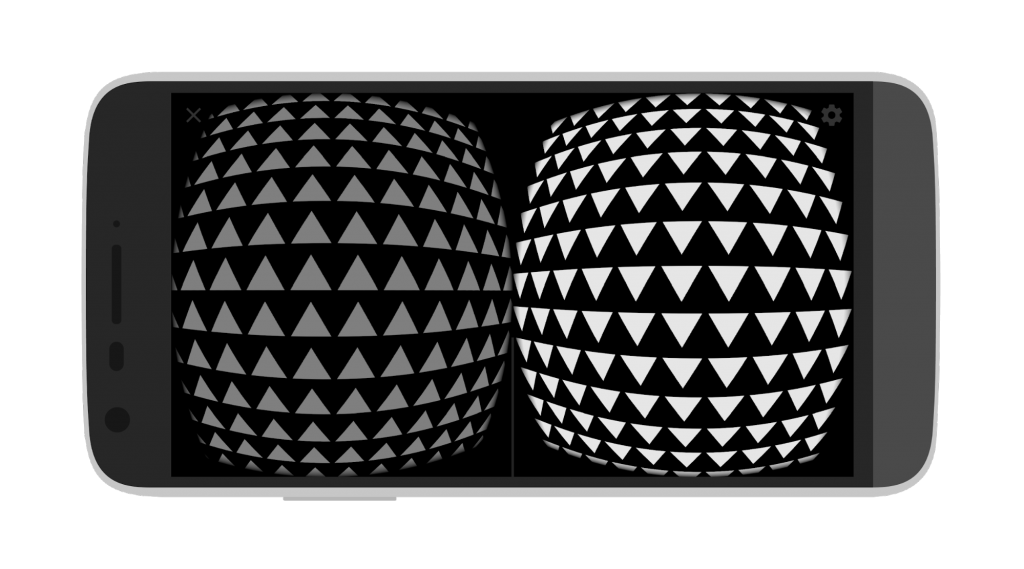
The picture above is perceived as looking something like this by the mind:
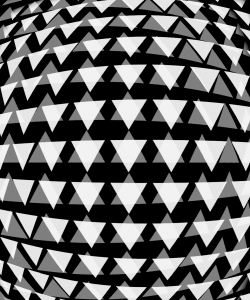
Once we know by how much we need to strengthen one signal channel to break suppression (and whether or not, for that person, it is necessary!) we can continue to the next phase.
Bending the world to straighten it – achieving fusion!
In our misalignment measurement scene we display two rods with a sphere at the end to each eye. These are rendered as two different colours for reasons that shall become obvious, and each is only visible in one eye. We apply the suppression breaking luminance ratios from the previous step so that the participant can actually see both rods.
Our goal is to find the degree to which we need to realign the world in one eye, such that the perceived position of each object in a scene is perfectly aligned at the back of each retina.
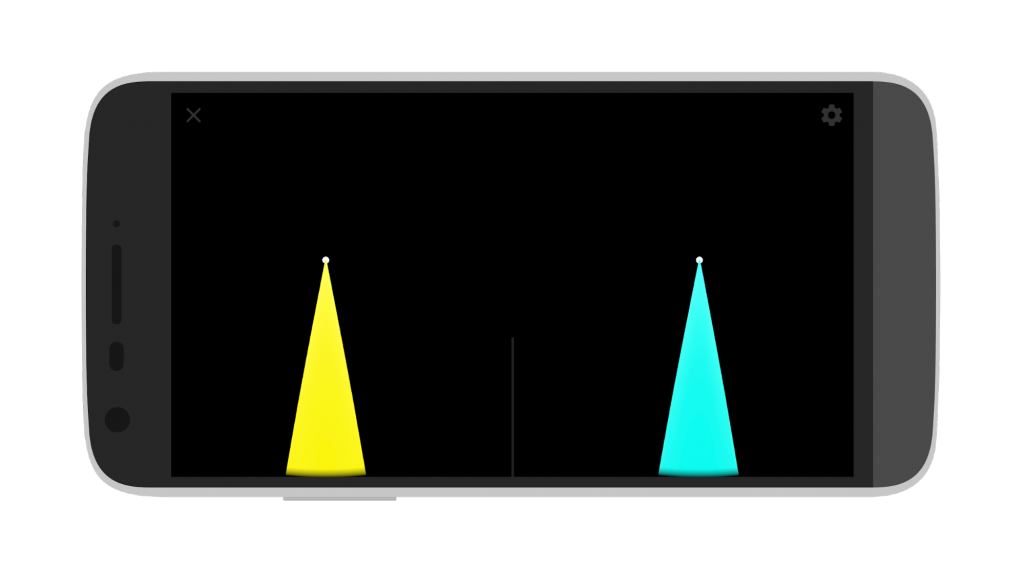
For example, the above starting position may be mentally perceived by a exotropic as the blue rod being to the left of the yellow rod rather than overlapping. First the operator selects the strabismic eye (which may vary from time to time in the case of an alternating strabismic) and then moves their head in any direction to reposition either the left or right rod :
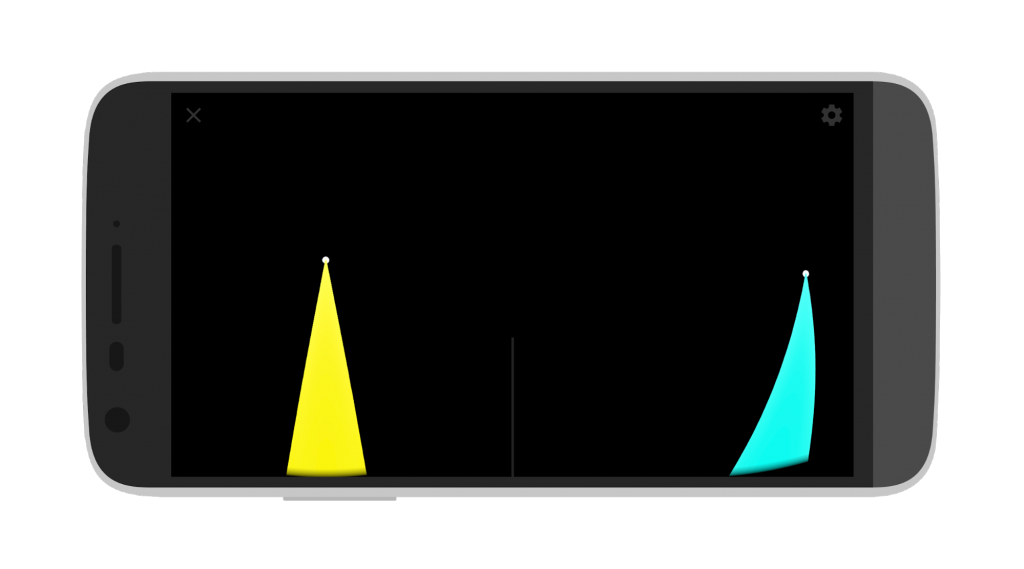
That same right-eyed exotropic (the right eye falling to the outer-side of the face) may move the rods into the position shown above (the distortions are cancelled out by the lenses in the VR headset so do not appear in their perception) as being perfectly situated atop one another. When this happens the mind perceives something known as an “impossible colour” which is a shimmering mixture of yellow and blue. It is quite striking, beautiful, and instantly recognisable. The operator indicates that the images are overlapping perfectly (a simple form of visual fusion) and we store this angle to reuse in all following scenes where we wish to overcome the misalignment angle of the participant’s eyes.
At this point, we have implemented something like an optical prism designed to compensate for the eye misalignment.
From fusing two into one, towards perceiving depth
Once both eyes, despite being misaligned, are able to perceive the world as if they were both straight, it becomes possible to recognise depth depending on the relative position of objects. This occurs for objects which appear to be under 6m in distance, causing both eyes to draw towards the nose in order to simultaneously focus on the object.
The following scene tests and stretches the participants ability to do just this, by presenting a classical test in which a series of circles are displayed in a circle. At random, the relative position of these circles is altered for each eye individually, causing it to appear closer than the other circles. We repeat this selection at random, with ever smaller distances between the raised circle and its neighbours. In this way we can discover whether the participant has any depth perception, and to what degree it is able to differentiate depth.
It’s ok to be straight!
Perhaps, by this point, the participant is experiencing fusion, and even depth perception – despite having misaligned eyes and outside the headset, only being able to use one eye. As soon as they remove the headset, the very misalignment of their eyes will cause a confusing double-vision and suppression (amblyopia) will kick back in.
Their mind needs to gain the experience and habit, that it is possible to hold fusion with both eyes straight. Ideally, eventually, the participant is thus able to remove the headset whilst their eyes are straight enough, and their mind familiar enough with the concept, that it chooses to maintain fusion and eye straightness, rather than triggering eye suppression and allowing one to fall to a side.
The following scene is designed to enable check-points to assess how far a participant has come in their ability to straighten their eyes.

We display two circles, in accordance with the misalignment of the participants eyes. In this case, the right circle is further to the right than the left, which implies the participant is exotropic in the right eye (for the participant, both appear to be overlapping perfectly). The operator triggers a process which then very gradually begins to rotate the world seen by the right eye towards a straight position. The participant attempts to maintain fusion, and indicates when this fails.
This is akin to the implementation of a dynamic prism. It is theoretically possible to implement such a form of prism in the physical world, but we are not aware of its existence and it would be too expensive for casual use.
Clinical use
What exactly the participant perceives, is surprisingly varied. We have designed each scene such that it can be precisely manipulated and altered to ask different questions of the perceptions of the participant. To this end, it is crucial that the practitioner is able to see what the participant can see, and drive their experience even though the device is in the VR headset on the participant’s head.
We have constructed a system which allows us to export, in real-time, both auto-generated web controls and pictures of what is currently happening in the participant’s headset, to an arbitrary number of watchers via their web-browser. A very useful tool indeed.
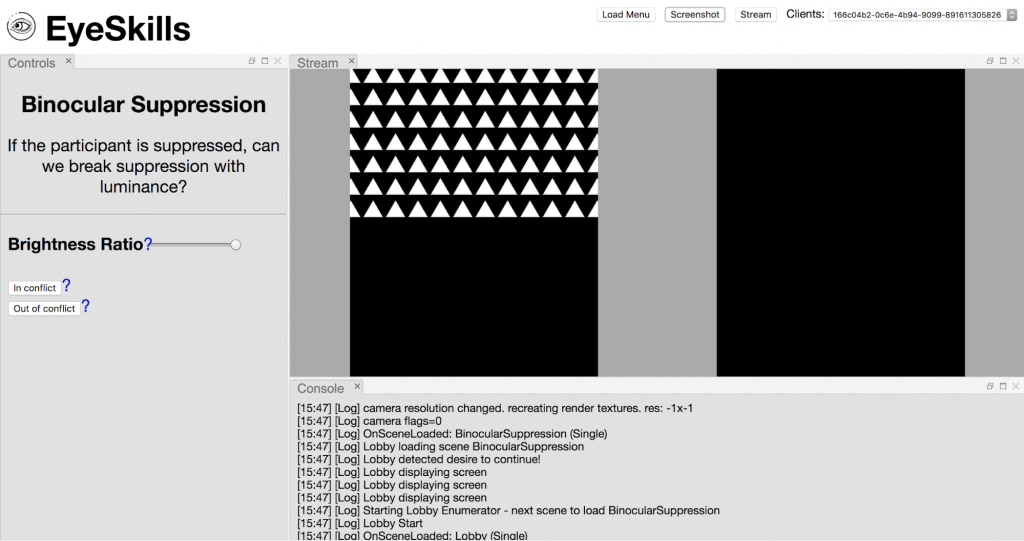
The Take-Home
The previous scenes are mostly diagnostic in nature, but serve to demonstrate the arc the take-home system will follow. The distinguishing factor will be that the take-home system allows the participant free-range, without any pressure, to explore what their vision is capable of in an environment which is as self-explanatory as possible.
Challenging assumptions
Finally, we wish to build on the take-home version to include a series of gamified challenge environments which stress different aspects of the visual system, in isolation and collectively.

